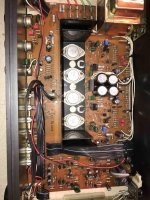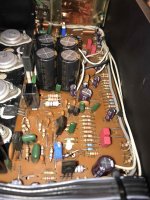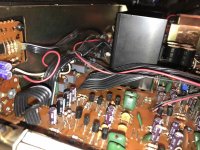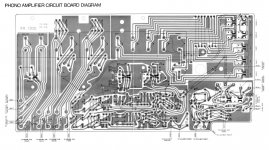Hi,
Have just recapped my owned-from-new NAD 3020A.
Sounds good on first outing and have managed to get 0mV DC on the speaker posts.
Attaching some photos.
Prior to buttoning it up, please could anyone knowledgeable on the recapping of this particular amp let me know if I’ve made any obvious mistakes or omissions?
I used Nichicon UKL in the audio signal path (hope I got the correct locations…), UPW elsewhere, except 4 UKW 33000uF for the power supply.
A sprinkling of Wima caps.
(Have to say that most of the pulled caps gave reasonably good readings on a cheap transistor tester.)
Many thanks all.
Have just recapped my owned-from-new NAD 3020A.
Sounds good on first outing and have managed to get 0mV DC on the speaker posts.
Attaching some photos.
Prior to buttoning it up, please could anyone knowledgeable on the recapping of this particular amp let me know if I’ve made any obvious mistakes or omissions?
I used Nichicon UKL in the audio signal path (hope I got the correct locations…), UPW elsewhere, except 4 UKW 33000uF for the power supply.
A sprinkling of Wima caps.
(Have to say that most of the pulled caps gave reasonably good readings on a cheap transistor tester.)
Many thanks all.
Attachments
Good job, it looks great.
Have you noticed any improvement in the sound?
Did you recap it because it is fashionable or did it work badly?
Have you noticed any improvement in the sound?
Did you recap it because it is fashionable or did it work badly?
Thank you Academia50!
Hmm, good question. It did sound very good already, but it occasionally had a stutter near power up. I'd replaced two little caps that typically cause this sort of problem but it still had a similar issue, hence the full on recap. Yet to properly test it with better speakers and source. It certainly sounds clean. Also yet to adjust bias..
Hmm, good question. It did sound very good already, but it occasionally had a stutter near power up. I'd replaced two little caps that typically cause this sort of problem but it still had a similar issue, hence the full on recap. Yet to properly test it with better speakers and source. It certainly sounds clean. Also yet to adjust bias..
Forgot to say that I especially want to use this amp for PHONO duty.
Can anyone highlight the components of this section on the board, or point out anything I should do that would optimise it's phono performance?
Can anyone highlight the components of this section on the board, or point out anything I should do that would optimise it's phono performance?
A work colleague was about to skip some hi-fi including a 3020, it was saved and gave about 5 years service until a buzz started, so I replaced the power supply caps and the buzz went and the bass became better, before it took about 4 hours to warm up until it had decent bass. Unfortunately when I did it the battery in my continuity tester was flat so I couldn't test anything, I about s##t myself on turn on. It gave a few more years of service until I got a cheep digital amp ( dollytec breaze or something ), as much as I enjoyed the nad, it sounds well dull in comparison. It's possible that the preamp/phono stage is the best bit of it.
Maybe it sounds boring to you. And maybe the unknown amp would sound shrill or unnatural to me if I could hear it.
He was once a killer of giants. And it's still a highly sought after amp.
He was once a killer of giants. And it's still a highly sought after amp.
Forgot to say that I especially want to use this amp for PHONO duty.
Can anyone highlight the components of this section on the board, or point out anything I should do that would optimise it's phono performance?
The pre of the NAD 3020 was sold separately as PP1 and later PP2
Maybe someone who could have the circuit or search the web, some improvements were made to it.
Thank you Academia50!
Hmm, good question. It did sound very good already, but it occasionally had a stutter near power up. I'd replaced two little caps that typically cause this sort of problem but it still had a similar issue, hence the full on recap. Yet to properly test it with better speakers and source. It certainly sounds clean. Also yet to adjust bias..
The same thing happened to me, I replaced the source caps (x somewhat higher UF) and the diode bridge with one of higher A.
I currently enjoy it as a pre and have not altered it, I really would not recommend it.
If something works well, leave it as is is my maxim
I agree, it's a matter of taste. Perhaps it's because I usually listen at low volumes that I prefer a sharper sound, I was also using an ESS dac at the time and they're quite smooth. I think one magazine compared a really expensive pre-amp against a nad 3020 pre-amp section, and the preferred the nad.
You could start with some brief but honest user reviews on the PP1 or PP2 at audio review.com, for example. It's often described as very good value for money but doesn't have the sweet top end that is usually a feature of much more expensive, mainstream phono preamps.
NAD's preamp may be said to be good in comparison to the token phono preamps in most budget amplifiers of the 1970s, 80s, 90s but you won't get more than you pay for in that highly competitive, low price market where the aim is to be the best of the low rather than the high end of Hifi. For some perspective, new prices of around $1-2,000 US aren't unusual for high-end phono preamps.
NAD's preamp may be said to be good in comparison to the token phono preamps in most budget amplifiers of the 1970s, 80s, 90s but you won't get more than you pay for in that highly competitive, low price market where the aim is to be the best of the low rather than the high end of Hifi. For some perspective, new prices of around $1-2,000 US aren't unusual for high-end phono preamps.
Thanks everyone.
Ian, I have a Rotel RA-1412, possibly their best integrated.. but would it's phono section be of genuinely high quality and a better bet than the NAD?
Ian, I have a Rotel RA-1412, possibly their best integrated.. but would it's phono section be of genuinely high quality and a better bet than the NAD?
No problem. I downloaded one from hifiengine and just had a cursory read. That's quite a big and powerful amp you have there. The phono preamp section though, is a fairly standard Japanese design for the period (1976). Despite having no experience with the model, I'll say that early Japanese amplifiers never excelled at disc input circuits and I wouldn't expect too much from it in regard to phono performance. The noise spec is only a standard -75bB but given an overhaul with modern MLCC caps for some of those small electrolytics in there, it might then have a bit more sparkle at least.
The 3020 and PP1/2 preamps are actually a little simpler but not all that different or special in comparison to Rotel's. I don't have all the schematics to be certain about PP1/2 though. However, the obvious reason NAD's preamps are liked is because just like most NAD products, they were affordable and hence the most popular, whilst the bulk of high-end phono gear has always been too high-end to waste your money on. Some boutique style manufacturers were lucky to sell 200 preamps per year which meant prices were necessarily high by large factors, even before CDs became the norm.
The 3020 and PP1/2 preamps are actually a little simpler but not all that different or special in comparison to Rotel's. I don't have all the schematics to be certain about PP1/2 though. However, the obvious reason NAD's preamps are liked is because just like most NAD products, they were affordable and hence the most popular, whilst the bulk of high-end phono gear has always been too high-end to waste your money on. Some boutique style manufacturers were lucky to sell 200 preamps per year which meant prices were necessarily high by large factors, even before CDs became the norm.
Might be better to build an external phono stage yourself. These are several very good ones
described here on diyAudio. You also could keep it when you replace the amplifier.
described here on diyAudio. You also could keep it when you replace the amplifier.
Last edited:
Maybe it sounds boring to you. And maybe the unknown amp would sound shrill or unnatural to me if I could hear it.
He was once a killer of giants. And it's still a highly sought after amp.
NAD 3020: Vintage hi-fi that still sounds great - CNET
Company Information - NAD Electronics
I met several people who sold their highly regarded amplifiers (P.E Accuphase) when they heard the Nad 3020 ......
Sure, it's all plastic rather than polished aluminum fronts and beautiful knobs, but Edvardsen's design aimed at one thing only, the sound.
In those years I remember that I was present when a very qualified technician was measuring its power and distortion. And he told me that he couldn't believe that with such a small electrolytic bank it would deliver such clean power. So I bought the "ugly duckling" and got rid of the beautiful Akai AA5810 without a second thought.
NAD is New Acoustic Dimension.
( It does not say so in the account of its origins. )
Last edited:
Thanks everyone.
Ian, appreciate the assessment of the Rotel and NAD, and the overview on phono amp products/economies of scale/price/performance. Worth bearing in mind.
3020A now sounding very good, virtually no extraneous sounds at full volume when no source is connected.
However, when ‘phono’ is selected it has a loud ‘hiss’ and this is louder through one channel (left.)
Given that all the caps have just been replaced is there a remaining likely culprit?
I’ve been advised to replace a few of the low value ceramic discs in order to optimise the ability of the phono/pre-amp ( photo attached.)
Might doing this happen to conjure a cure, and is it a worthwhile thing to do anyway?
Or is the hiss likely caused by a different issue?
Ian, appreciate the assessment of the Rotel and NAD, and the overview on phono amp products/economies of scale/price/performance. Worth bearing in mind.
3020A now sounding very good, virtually no extraneous sounds at full volume when no source is connected.
However, when ‘phono’ is selected it has a loud ‘hiss’ and this is louder through one channel (left.)
Given that all the caps have just been replaced is there a remaining likely culprit?
I’ve been advised to replace a few of the low value ceramic discs in order to optimise the ability of the phono/pre-amp ( photo attached.)
Might doing this happen to conjure a cure, and is it a worthwhile thing to do anyway?
Or is the hiss likely caused by a different issue?
Attachments
If the phono stage is hissing now and it wasn't before modification you have to think about what has changed.
It seems to be a lot when you replace 4700uF supply capacitors for 33,000uF and some diodes shown as 1N4148 in a service manual are now in larger blue cases.
Charging of capacitors occurs over short time at the peak of an AC cycle and in order to supply more energy to charge 33,000uF the voltage has to increase which will result in a spike on supply rails.
That may not matter if you are restricting the use to the phono stage because the current drawn by that will be minimal.
Nonetheless you are still going to have a huge charging current surge at switch on which will increase the strain on the rectifiers and transformer and fusing.
Some high current amplifiers have soft start circuits but the simplest route to doing a recap is to keep faith with the original component types and values.
It seems to be a lot when you replace 4700uF supply capacitors for 33,000uF and some diodes shown as 1N4148 in a service manual are now in larger blue cases.
Charging of capacitors occurs over short time at the peak of an AC cycle and in order to supply more energy to charge 33,000uF the voltage has to increase which will result in a spike on supply rails.
That may not matter if you are restricting the use to the phono stage because the current drawn by that will be minimal.
Nonetheless you are still going to have a huge charging current surge at switch on which will increase the strain on the rectifiers and transformer and fusing.
Some high current amplifiers have soft start circuits but the simplest route to doing a recap is to keep faith with the original component types and values.
Thanks Mjona.
There may be times when I'll want to use the amp as an integrated, but right now I really want to optimise it's performance as a phono (and, occasionally, a pre-amp.)
The hiss was actually there before the recap.
Probably just better defined and imaged now : )
There may be times when I'll want to use the amp as an integrated, but right now I really want to optimise it's performance as a phono (and, occasionally, a pre-amp.)
The hiss was actually there before the recap.
Probably just better defined and imaged now : )
If your amplifier has a switch to accept signals from moving coil and moving magnet phono cartridges the contacts could have oxidized and be in need a spray can contact cleaner. This could also be useful for other purposes like scratchy volume controls and various connectors.
- Home
- Amplifiers
- Solid State
- NAD 3020A recap assessment







